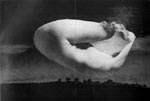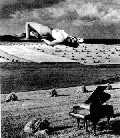 |
Vol 2, No 7 21 February 2000 |
|
|
Karel Teige: Avant-garde Typography and Surrealist Collage Czech Centre, London, until 3 March 2000 Sue Bagust Although Karel Teige was a prolific artist and theorist of the Czech avant-garde with work in a wide variety of media, the current exhibition has chosen to concentrate on just two aspects of Teige's varied output – his collages and his typography. The surrealist collages, which are hung on the walls of the spacious and newly renovated gallery in the Czech Centre's Great Portland Street premises, were not primarily intended for public exhibition. They were produced by Teige for private use and were never exhibited during his lifetime. Teige produced over 300 of these collages between the years of 1935 and 1951 and very few of them were released until the year after his death, when they were published in the samizdat journal Zodiac by the surrealist group of which he was leader. This fact is significant since one of the aims of the Prague Devětsil group had been to use new forms such as the pictorial poem as a way of anticipating the extinction of the hung picture, with its bourgeois and capitalist associations. Teige's vision, that art should become life and art should be made by everyone, is encapsulated in the very genre of collage. For Teige, these collages were both a personal lyrical expression of his own (very male) subjective awareness and also a visual interpretation of his ideology. Inner expression As an expression of personal emotion, the erotic element is important to Teige's collages. Most of them use the re-assembled parts of the female body in conjunction with other elements, such as bits of machinery or landscape. The juxtaposition of these different metaphors is a challenge to the outsider, who through this exhibition is invited to the inside of Teige's mind.
Although these collages are unmistakably Czech in feeling – many of them feature the Czech countryside – all the collages in this exhibition have the hallmark of the international surrealist movement and influences of such artists as René Magritte, Max Ernst and Man Ray. Teige absorbed the strategies of the modern movement during his trips to Paris in the 1920s; he then disseminated these influences among his many contacts and through his role as a prolific publisher and editor. The effect of Man Ray was particularly potent in the Czech-speaking world, an influence that can be seen in many of these collages. Underestimated creativity This exhibition demonstrates Teige's importance as an active, creative artist who was very much a part of the modern movement. This role has been overlooked until quite recently, not only because so little of Teige's cubist work from the 1920s has survived, but mainly because his identity as a theorist, editor and typographer has eclipsed the creative aspect. To some extent this is because Teige's priority was always the cause of Marxist society, a utopia he believed in and hoped for. Around the time he began to produce his collages, he speculated about "the possible interrelationship between socialist realism and surrealism." The hope he had of such a relationship was cruelly dashed with Stalin's Moscow trials of 1936, during which many of Teige's friends were expelled from the Communist Party. Teige's desperate thoughts found expression in collages of this period, for example No 278 of 1939 which is made up from photoreportage of a Moscow street with fragments of a ballerina. As Vojtěch Lahoda says an article, which appears in MIT Press's new book on Teige "It is as if in Teige's collages one can hear the reverberations of the Moscow trials and the thunder of the marching feet of the brownshirts during their book burning frenzies in Germany." Because surrealism is based on the irrational language of the subconscious, its meanings are subliminal and opaque. Works of surrealism have to be "read" like the metaphors in a poem, rather than just looked at as aesthetic objects. However, this is especially the case with Teige's pieces since they represent such a private aspect of his artistic expression. Out of context Given this difficulty, it might have been helpful to have had some of Teige's statements displayed as an aesthetic context for the collages. However, the provision of an excellent bilingual catalogue produced for the exhibition of the collection in Prague a few years ago made up for the lack of aesthetic and historic pointers in the exhibition. The range of his book covers was also impressive, again showing the importance of Teige's international links, with titles about such figures as diverse as the French experimental poet Guillaume Apollinaire and Charlie Chaplin. However, a lack of help with contextualising was also a problem with this side of the exhibition, with the covers which were displayed in glass cases in the centre of the room. Nevertheless, the exhibition is a worthy and successful attempt to bring a previously neglected figure in Czech modernism back to the fore of thinking on the avant-garde. All the more so, since at the same time it reveals a new side to the man and his art. Sue Bagust, 21 February 2000
|
|
![]()
Copyright © 2000 - Central Europe Review and Internet servis, a.s.
All Rights
Reserved

